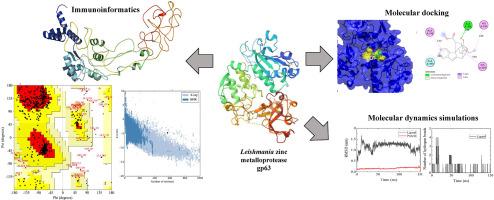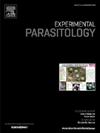Targeting the zinc metalloprotease gp63 of Leishmania for vaccine design and new drug discovery using immunoinformatics, molecular docking and molecular dynamics simulation studies
IF 1.6
4区 医学
Q3 PARASITOLOGY
引用次数: 0
Abstract
Leishmaniasis is a vector-borne parasitic disease caused by Leishmania spp., for which there is no vaccine and an urgent need for better drugs. The zinc metalloprotease gp63 of Leishmania has been identified as an antigenic structure for vaccine design and a promising target for new antileishmanial agents. In this study, immunoinformatics was used to design a full vaccine construct with the cytotoxic T-lymphocyte (CTL) and helper T-lymphocyte (HTL) epitopes of gp63 from Old and New World Leishmania spp. The vaccine construct comprising of these epitopes, with suitable adjuvant and linker sequences, was found to be thermostable, highly antigenic and non-allergenic. A total of 13 linear B-cell epitopes, and 12 continuous and four discontinuous B-cell epitopes, were further identified using the BepiPred and ElliPro prediction programs, respectively. In addition, molecular docking and molecular dynamics simulation studies were performed to identify new antileishmanial molecules with the potential to target gp63. Nareline - a phytomolecule from the antileishmanial plant Alstonia scholaris - showed the best predictive binding affinity for gp63, forming stable interactions with key residues in the active site of this protein. This study highlights the promising role of gp63 in the search for new vaccines and therapeutic agents to combat leishmaniasis.

基于免疫信息学、分子对接和分子动力学模拟研究的针对利什曼原虫锌金属蛋白酶gp63的疫苗设计和新药开发
利什曼病是一种由利什曼原虫引起的媒介传播的寄生虫病,目前还没有疫苗,迫切需要更好的药物。利什曼原虫锌金属蛋白酶gp63已被确定为疫苗设计的抗原结构和新的抗利什曼原虫药物的有希望的靶点。本研究利用免疫信息学方法设计了含新旧利什曼原虫gp63细胞毒性t淋巴细胞(CTL)和辅助性t淋巴细胞(HTL)表位的完整疫苗结构,该疫苗结构包含合适的佐剂和连接序列,具有耐热性、高抗原性和非过敏性。使用BepiPred和ElliPro预测程序进一步鉴定了13个线性b细胞表位,12个连续b细胞表位和4个不连续b细胞表位。此外,我们还进行了分子对接和分子动力学模拟研究,以鉴定可能靶向gp63的新抗利什曼原虫分子。Nareline是一种来自抗利什曼病植物Alstonia scholaris的植物分子,对gp63表现出最好的预测结合亲和力,与gp63蛋白活性位点的关键残基形成稳定的相互作用。这项研究强调了gp63在寻找对抗利什曼病的新疫苗和治疗剂方面的有希望的作用。
本文章由计算机程序翻译,如有差异,请以英文原文为准。
求助全文
约1分钟内获得全文
求助全文
来源期刊

Experimental parasitology
医学-寄生虫学
CiteScore
3.10
自引率
4.80%
发文量
160
审稿时长
3 months
期刊介绍:
Experimental Parasitology emphasizes modern approaches to parasitology, including molecular biology and immunology. The journal features original research papers on the physiological, metabolic, immunologic, biochemical, nutritional, and chemotherapeutic aspects of parasites and host-parasite relationships.
 求助内容:
求助内容: 应助结果提醒方式:
应助结果提醒方式:


